Pervaporation of Aqueous Solution of Acetaldehyde Through ZSM-5 Filled PDMS Composite Membrane*
WU Yanhui (伍艷輝)**, TAN Huifen (譚惠芬), LI Dongming (李佟茗) and JIN Yuan (金源)
Department of Chemistry, Tongji University, Shanghai 200092, China
1 INTRODUCTION
Acetaldehyde is one of the most important chemical intermediates in chemical industry. It can be used to synthesize butanol, acetone, acetic anhydride,trichloroacetaldehyde and so on. Several traditional processes, such as acetylene hydration and ethane oxidization, have been used to produce acetaldehyde, generating acetaldehyde waste water that is toxic and hazardous to the environment and creatures. Thus the treatment of acetaldehyde waste water becomes urgent [1, 2].
Several methods are used to treat acetaldehyde waste water such as distillation [3-5], adsorption [6] and condensation [7]. In addition, pervaporation, a novel and effective membrane technique, is suitable for separating organics from its dilute aqueous solution [8, 9].Due to its simplicity, high permselectivity, energy and cost saving, pervaporation technique presents enormous potentiality in water treatment. For example, toluene was removed from the wastewaters of chemical industry with unfilled and carbon black filled polydimethylsiloxane (PDMS) membranes, with the removal of toluene amounted to 90% and 93% for PDMS +carbon black and PDMS, respectively [10]. Similarly,Peng et al. [11] obtained extremely high separation factor and acceptable permeation flux for removal of toxic volatile compound benzene from aqueous solution with carbon molecular sieve filled PDMS membranes. The processes coupled with pervaporation of acetaldehyde were also investigated. Papaefstathiou et al. [12] separated acetaldehyde with polytetrafluoroethylene (PTFE) membrane from 2% (by volume)aqueous solution of acetaldehyde by pervaporation and determined acetaldehyde by combining enzymic method. Gas chromatograph [13] and capillary electrophoresis [14] coupled with pervaporation pretreatment were applied to detect acetaldehyde and acetone successfully. Zeng and Zeng [15] separated the flavoring compositions in a new Chinese spirits by pervaporation with PDMS membrane at 40 °C and the removal efficiency of acetaldehyde reached 87% for the feed with 0.2 mg·ml-1acetaldehyde. In order to enhance the permeation flux and selectivity of acetaldehyde,more suitable membrane needs to be developed.
PDMS is a commonly used hydrophobic polymeric material for separating minor organic compounds from aqueous solution. The rapid motion of chain segments in PDMS leads to a large free volume that favors the diffusion of the permeating molecules.In recent years, some effective methods such as filling adsorbents into the polymers have been used to improve the permeation flux or selectivity. High-silica ZSM-5 zeolite filled PDMS composite membrane was applied to recover isopropanol from its aqueous solution [16]. With the increase of zeolite content in the mixed matrix membrane, the permeation flux and selectivity increased simultaneously.
In this work, considering that the high-silica ZSM-5 zeolite can improve the hydrophobicity and enhance the mechanical property of the composite membrane as mentioned in literature [16, 17], we prepare ZSM-5 zeolite filled PDMS composite membranes with Nylon microfiltration membrane as the support layer and use them to remove acetaldehyde from its aqueous solution by pervaporation. The chemical and physical properties of the composite membrane are characterized.The effects of ZSM-5 zeolite content and pervaporation operation conditions on pervaporation performance are investigated.
2 EXPERIMENTAL
2.1 Materials
107-silicone rubber (viscosity 5 Pa·s), tetraethylorthosilicate (TEOS) and dibutyltin dilaurate were obtained from Shanghai Resin Company. ZSM-5 zeolite (H type, Si/Al=360) with particle size of 3.5 μm was purchased from Shanghai Fuxu Molecular Sieve Limited Company. Ethyl acetate with analytical pure grade was supplied by Sinopharm Chemical Reagent Co., Ltd. Acetaldehyde was prepared from the depolymerization of paraldehyde (chemical pure grade, Aladdin Reagent Database Inc.) with concentrated sulfuric acid as the catalyst and then was used to make the acetaldehyde solution. The Nylon microfiltration membrane(pore diameter 0.45 μm) was bought from Shanghai Mosu Tech. Co., Ltd.
2.2 Membrane preparation
ZSM-5 zeolite was weighed and roasted in muffle furnace at 400°C for 5 h to remove the water and carbon dioxide adsorbed. The pretreated zeolite was then cooled to room temperature in a desiccator. 5 g of 107-silicone rubber was added into ethyl acetate with stirring until the silicone rubber dissolved completely.The pretreated zeolite was added into ethyl acetate with ultrasonic dispersion for 30 min. The two mixtures were mixed with crosslinking agent TEOS and catalyst dibutyltin dilaurate, stirred for 1 h. The prepared casting solution was toppled on a Nylon membrane supported on a glass plate (the Nylon membrane was saturated with distilled water beforehand). Then the solution was cast with a glass scraper. The composite membrane was dried at 60°C for 12 h and peeled off from the glass plate when the solvent evaporated completely.
2.3 Membrane characterization
X-ray powder diffraction (XRD, D8FOUCUS,Bruker AXS) was used to examine the crystalline diffraction characteristics of the PDMS, ZSM-5 and ZSM-5-PDMS samples. The radiation was generated using Cu Kα(λ=0.154 nm) from graphite monochromator at 40 kV and 100 mA. The scanning rate was 2(°)·min-1and the scanning range was 10°-70°.
The diffuse reflectance infrared Fourier transform spectroscopy (DRIFTS) experiments were carried out on a Bruker Vector 22 FTIR spectrometer equipped with a MCT detector and Harrick diffuse reflectance accessory. All infrared data were evaluated in Kubelka-Munk units. Background signals from gas-phase were subtracted before the spectra were reported.
SEM 515 scanning electron microscopy (Phillip Corp.) was used to observe the surface and cross-section morphologies of the membranes.
The thermal stability of the membranes was measured by thermogravimetric analyzer (Q600SDT,TA Instrument Inc.) at a heating rate of 10 K·min-1in nitrogen atmosphere.
2.4 Swelling study
The dried ZSM-5-PDMS membrane was weighed and immersed in aqueous solution of acetaldehyde at 25 °C. Then the membrane sample was taken out at intervals and wiped carefully with filter paper to remove the liquid on the surface. After weighed, the sample was put back into the acetaldehyde aqueous solution again until its mass was unchanged. The degree of swelling (DS) was determined by

where Wsand Wdare the mass of swollen and dry membranes, respectively.
2.5 Pervaporation measurement
The schematic diagram of the experimental equipment for pervaporation is shown in Fig. 1. The acetaldehyde aqueous solution in liquid reservoir was sent to the membrane cell by a recycle pump. With the vapor pressure difference over the membrane, part of the feed liquid permeated through the membrane and evaporated in vacuum environment. The permeate was condensed and collected in a liquid nitrogen cold trap and the retentive feed liquid was circulated back to the liquid reservoir. The feed temperature was controlled by the temperature-controller and the feed flux was measured by a rotameter. The temperatures at the entrance and exit of the membrane cell were measured by the thermocouples. The effective membrane area was 3.6×10-3m2. The permeate mass was obtained by weighing the collector.
The concentrations of permeate and feed liquid were measured by gas chromatography (GC7890F,TECHCOMP [HOLDINGS) LIMITED]. The column was HP-FFAP capillary column. The pervaporation performance is usually described with separation factor α and permeation flux J,
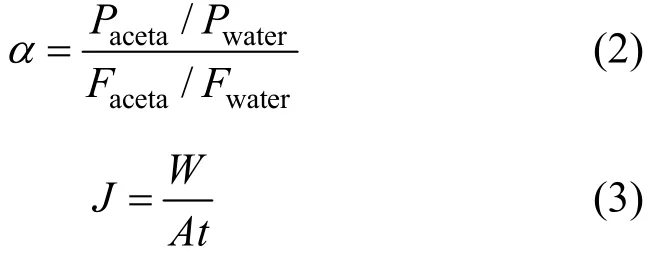
where Pwaterand Pacetaare mass fractions of water and acetaldehyde in permeate, respectively; Fwaterand Facetaare mass fractions of water and acetaldehyde in liquid feed, respectively; J is the permeation flux, g·m-2·h-1;W is the mass of the permeate, g; A is the effective membrane area, m2; and t is the permeation time, h.
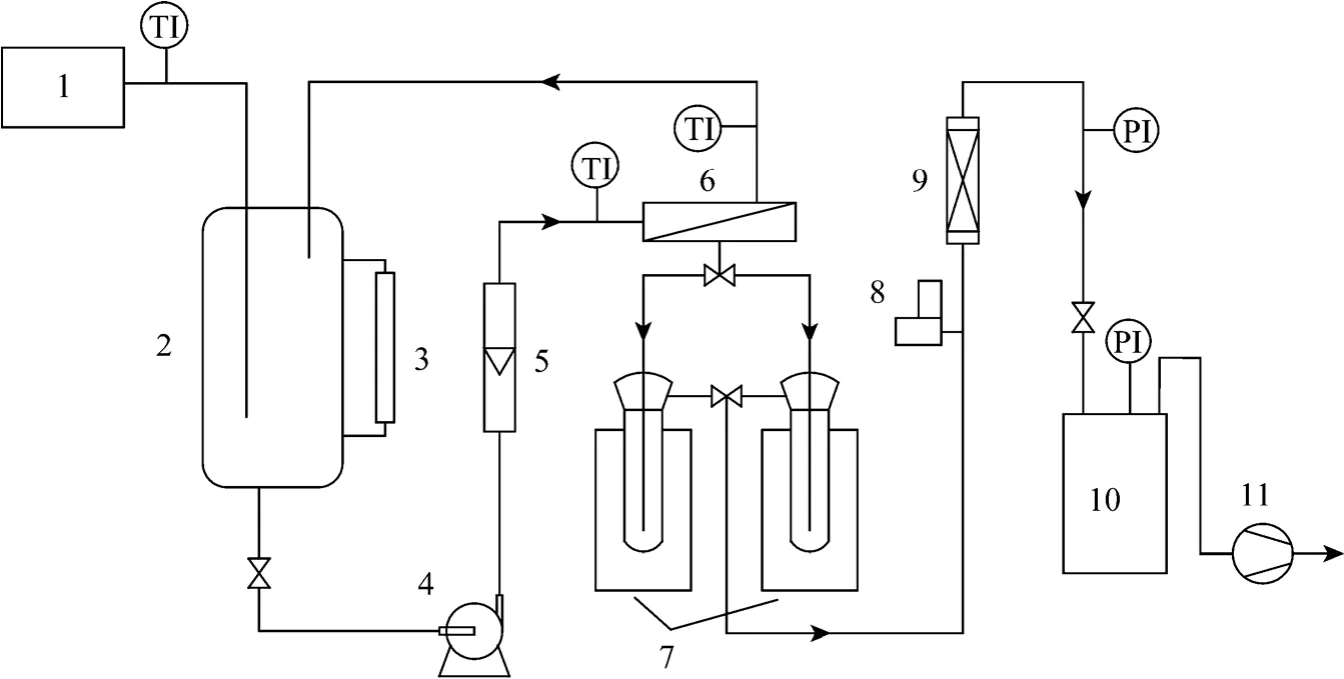
Figure 1 Schematic diagram of the pervaporation (PV) equipment1—temperature control unit; 2—liquid reservoir; 3—level gauge; 4—liquid pump; 5—rotameter; 6—membrane cell; 7—cold trap;8—pressure sensor; 9—dryer; 10—vacuum buffer; 11—vacuum pump
3 RESULTS AND DISCUSSION
3.1 Membrane characterization
3.1.1Fourier transform-infrared (FT-IR) analysis
The FT-IR spectra of PDMS/Nylon and 5%ZSM-5-PDMS/Nylon membranes are displayed in Fig. 2,which seem very similar. A stretching vibration band of C H appears at 2962 cm-1and a stretching vibration band of SiC is at 1260 cm-1. 1000-1150 cm-1is the characteristic absorption band of SiO Si. 800 cm-1is the stretching vibration band of SiC. In 5%ZSM-5-PDMS/Nylon membrane, the characteristic absorption band of SiO Si is much weaker than that in PDMS/Nylon membrane. There are two reasons accounting for this: incorporation of ZSM-5 zeolite may destroy the crosslinking of PDMS and TEOS,and OH in ZSM-5 zeolite forms hydrogen bond with O in SiO Si.

Figure 2 FT-IR spectra of PDMS/Nylon and ZSM-5-PDMS/Nylon samplesPDMS/Nylon; 5%ZSM-5-PDMS/Nylon
3.1.2XRD analysis
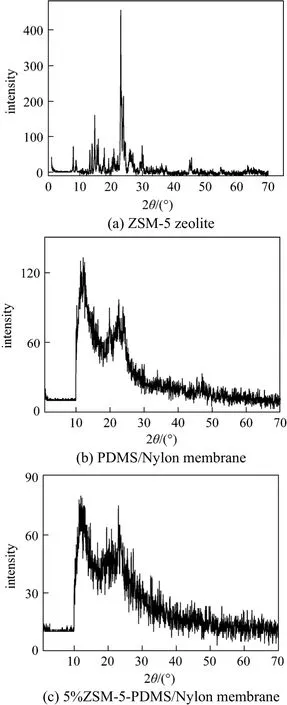
Figure 3 XRD patterns for ZSM-5 zeolite, PDMS/Nylon membrane and 5%ZSM-5-PDMS/Nylon membrane
The XRD patterns of ZSM-5 zeolite, PDMS/Nylon and 5%ZSM-5-PDMS/Nylon samples are shown in Fig. 3. The characteristic diffraction peaks of ZSM-5 zeolite are at 8.0°, 8.9°, 23.1°, 23.3° and 24.0° [18].Comparing Fig. 3 (b) with Fig. 3 (c), we can see the characteristic diffraction peak of PDMS at 11.8° and diffraction peaks ranged from 23° to 24° in 5%ZSM-5-PDMS/Nylon sample. This demonstrates that the addition of ZSM-5 zeolite does not change the state of PDMS. The XRD pattern of ZSM-5-PDMS/Nylon composite membrane is the superposition of ZSM-5 zeolite and PDMS/Nylon samples.
3.1.3Thermogravimetric analysis
The thermogravimetric curves of PDMS and 5%ZSM-5-PDMS/Nylon samples are shown in Fig. 4.The two samples begin to decompose at about 200 °C and decompose completely at about 700 °C, because PDMS polymer is at rubbery state and the internal structure changes a lot as temperature increases. At about 350 °C the crosslinking structure is destroyed.
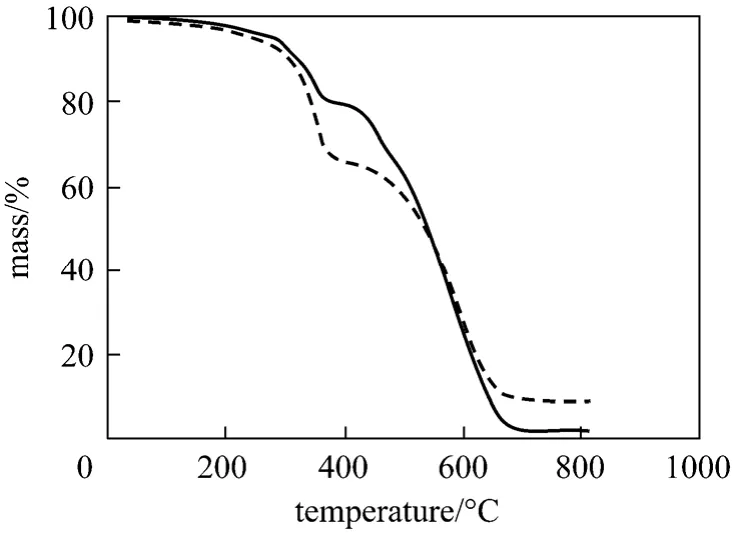
Figure 4 TG analysis curves of PDMS and ZSM-5-PDMS samplesPDMS/Nylon; 5%ZSM-5-PDMS/Nylon

Figure 5 SEM images of PDMS/Nylon and ZSM-5-PDMS/Nylon membranes
The analysis of FT-IR shows that incorporation of ZSM-5 would influence the crosslinking of PDMS.Therefore, the weight loss of the zeolite filled membrane from 350 to 450 °C is higher than that of the unfilled membrane. In the whole decomposing process,since zeolite is an inorganic particle, the mass loss of zeolite filled membrane is less.
3.1.4Scanning electron microscope (SEM) analysisFigures 5 and 6 show the SEM images of PDMS/Nylon, 5%ZSM-5-PDMS/Nylon and 15%ZSM-5-PDMS/Nylon membranes. The composite membrane filled with 15% ZSM-5 zeolite is very different from the unfilled membrane (Fig. 5). The PDMS dense layer of unfilled membrane is more homogeneous. The surface layer structure of ZSM-5 filled PDMS membranes with different ZSM-5 mass contents (Fig. 6) shows that the zeolite particles distribute uniformly in 5%ZSM-5-PDMS/Nylon membrane while agglomerate in 15%ZSM-5-PDMS/Nylon membrane. In the study of Sunet al. [19], zeolite ZSM-5 began to agglomerate at mass content of 10%.
3.2 Swelling and sorption properties of composite membrane
Figure 7 shows the swelling behavior of composite membranes in 8% aqueous solution of acetaldehyde at 25 °C. Compared with the PDMS/Nylon membrane, the zeolite filled membrane has lower DS value and takes shorter time to reach swelling equilibrium. The addition of zeolite is helpful to avoid the excessive swelling [20].

Figure 6 SEM images of the surface layer of ZSM-5-PDMS/Nylon membranes

Figure 7 Swelling curves of ZSM-5-PDMS/Nylon membrane at different times (8% acetaldehyde, 25°C)■ PDMS/Nylon; ● 2%ZSM-5-PDMS/Nylon;▲ 5%ZSM-5-PDMS/Nylon; ▼ 8%ZSM-5-PDMS/Nylon;◆ 15%ZSM-5-PDMS/Nylon
In swelling process, there are three steps in succession: (1) solvent molecules diffuse into the polymer system, (2) the polymer chains become relaxed, and (3)the polymer network expands in the solution. If step 1 is dominant, the amount of solvent adsorption will be directly proportional to the square root of time. If step 2 is rate-determining, the amount of adsorbed solvent is proportional to time,while the swelling degreevs.the square root of time exhibits sigmoidal pattern [21].In Fig. 7, the swelling degree curve of PDMS/Nylon membranes is sigmoidal, which means that the relaxation of polymer chains is the rate-determining step.For the ZSM-5 filled PDMS/Nylon membrane, the swelling degree looks more likely linear with the square root of time. The filled zeolite ZSM-5 influences the swelling process.
Hydrophobic ZSM-5 zeolite adsorbs acetaldehyde more easily than water, so the zeolite in the composite membrane has preferential sorption to acetaldehyde. Fig. 8 shows that the DS values of membranes in pure water and in acetaldehyde solution have similar trend as zeolite content increases in the membrane. And in the whole range, the DS value in water is lower than that in acetaldehyde solution.
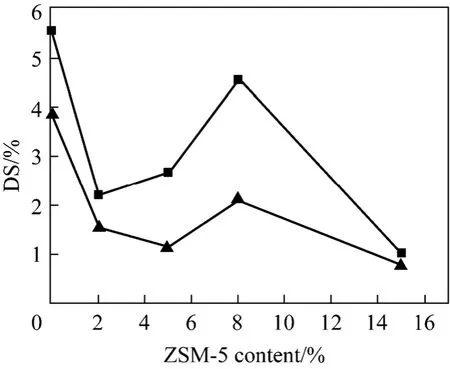
Figure 8 Effect of zeolite content on DS (25°C)■ in 8% acetaldehyde; ▲ in water
The membrane without filling zeolite has the highest DS in acetaldehyde solution and in water. The reason is that pure PDMS is a kind of rubbery polymer at ambient temperature [22, 23], so the active movement of PDMS segments makes its free volume relatively large [24]. After filling with ZSM-5 zeolite,the free volume of PDMS is partly inhabited by zeolite. Moreover, as a kind of inorganic filler, ZSM-5 zeolite is inflexible, which restricts the segment movement in PDMS-ZSM-5/Nylon membrane to some extent and therefore suppresses the swelling of the composite membrane.
Since ZSM-5 zeolite can improve the sorption of acetaldehyde but suppress the swelling of membrane,the DS of the composite membrane first increases and then decreases with increasing zeolite content (Fig. 8).When zeolite mass content exceeds 8%, the segment movement of PDMS in the composite membrane is weakened and the swelling suppression effect is dominant. Therefore, the quantity of adsorbed acetaldehyde solution is small in 15%ZSM-5-PDMS/Nylon membrane.
3.3 Pervaporation performance of composite membrane
3.3.1Effect of zeolite content
The effect of ZSM-5 zeolite content on selectivity of ZSM-5 filled PDMS composite membrane in 8% (by mass) acetaldehyde solution is shown in Fig. 9.The separation factor increases with zeolite mass content first and achieves the maximum value 35 at 5% zeolite content. The separation factor of 8%ZSM-5-PDMS/Nylon membrane is close to that of the membrane with 5%ZSM-5 content, both of which show better adsorption to acetaldehyde (Fig. 8). As the zeolite mass content increases to 15%, the smaller value of DS (Fig. 8)causes less adsorption of acetaldehyde molecules on the membrane, lowering the separation factor considerably. On the whole, the separation factor of ZSM-5 filled membranes is much better than that of the unfilled membrane.
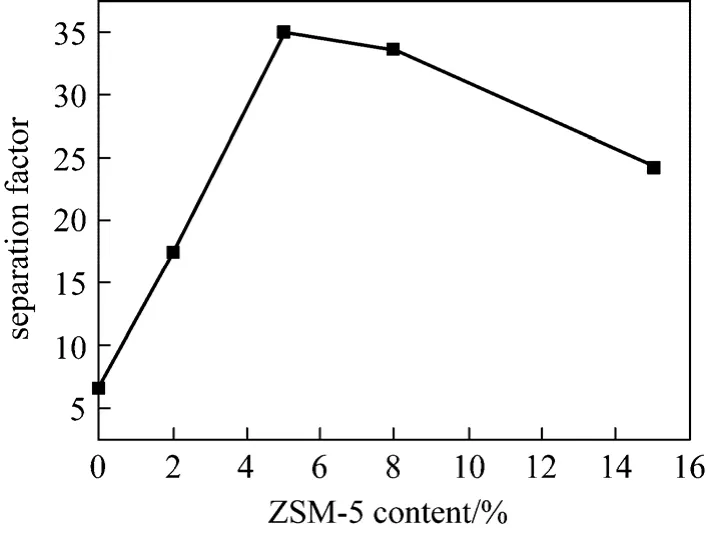
Figure 9 Effect of zeolite content on separation factor (8%acetaldehyde, 50 L·h-1, 25 °C)
The effect of zeolite content on permeation flux in 8% acetaldehyde solution at 50 L·h-1flow rate and 25 °C is shown in Fig. 10. The unfilled PDMS/Nylon membrane gives the maximum permeation flux (309.4 g·m-2·h-1), because the unfilled membrane has the highest DS in the aqueous solution of acetaldehyde,providing more free volume for the sorption and diffusion of acetaldehyde and water molecules. The zeolite filled membranes has lower permeation flux than the unfilled membrane as the zeolite suppresses membrane swelling and decreases the free volume of the composite membrane. As the zeolite loading increases,the sorption capacity of acetaldehyde increases while the sorption of water shows opposite trend. Since the DS of the composite membrane increases as zeolite mass content increases from 2% to 5%, the permeation flux of 5%ZSM-5-PDMS/Nylon membrane is higher than that of 2%ZSM-5-PDMS/Nylon membrane. However, further increase of zeolite content may lead to the aggregation of zeolite, so that the movement of segments decreases and the transport resistance of the filled membrane is increased [11]. Therefore, the permeation fluxes of 8%ZSM-5-PDMS-Nylon and 15%ZSM-5-PDMS-Nylon membranes are less. This phenomenon is in agreement with that in a previous pervaporation experiment with silicalite-filled polyether-block-amides membrane [20].
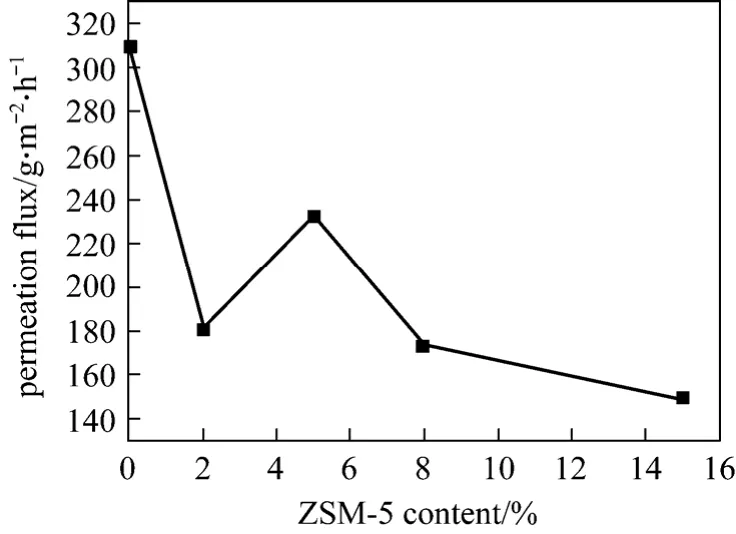
Figure 10 Effect of zeolite content on permeation flux (8%acetaldehyde, 50 L·h-1, 25 °C)
3.3.2Effect of feed concentration
The swelling of membrane has some relation with the concentration of acetaldehyde in the feed, so the feed concentration influences the membrane performance. As shown in Fig. 11, the total permeation flux of 5%ZSM-5-PDMS/Nylon membrane increases with the feed concentration. The reason is that PDMS and zeolite ZSM-5 are both hydrophobic, the DS of the composite membrane in acetaldehyde solution increases with its concentration. The interactions between PDMS polymer chains will be weakened when the DS is higher, enlarging the free volume of composite membrane. Then it is favorable for molecules to permeate through the membrane, increasing the total permeation flux. Fig. 12 shows the partial permeation flux of acetaldehyde and water at different feed concentrations. Although water molecule is smaller than acetaldehyde molecule, the water flux is lower than the acetaldehyde flux in this work since the composite membrane has preferential sorption to acetaldehyde.As the acetaldehyde concentration increases, the acetaldehyde flux increases, while the water flux decreases slightly. Similar tendency of partial permeation flux can be found in literature [11, 25, 26]. Higher acetaldehyde concentration in the membrane may hinder the diffusion of water through membrane.
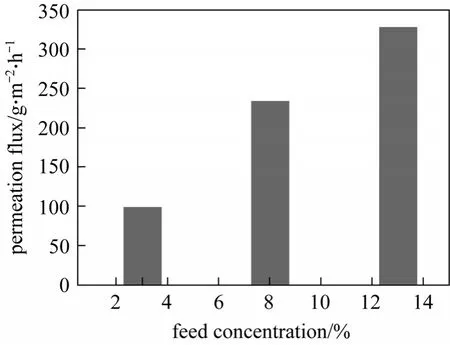
Figure 11 Effect of feed concentration on total permeation flux (5%ZSM-5-PDMS/Nylon, 25 °C, 50 L·h-1)
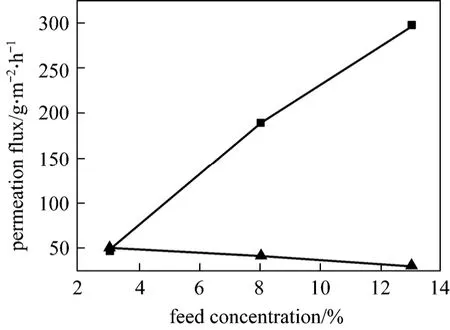
Figure 12 Effect of feed concentration on partial permeation flux (5%ZSM-5-PDMS/Nylon, 25 °C, 50 L·h-1)■ acetaldehyde; ▲ water
Figure 13 shows that the separation factor for 5%ZSM-5-PDMS/Nylon membrane also increases with feed concentration. The more acetaldehyde molecules adsorb on membrane surface, the more easily acetaldehyde permeates through the membrane. When the acetaldehyde concentration is higher, the sorption and solution of acetaldehyde in the membrane are improved, enhancing the permselectivity.
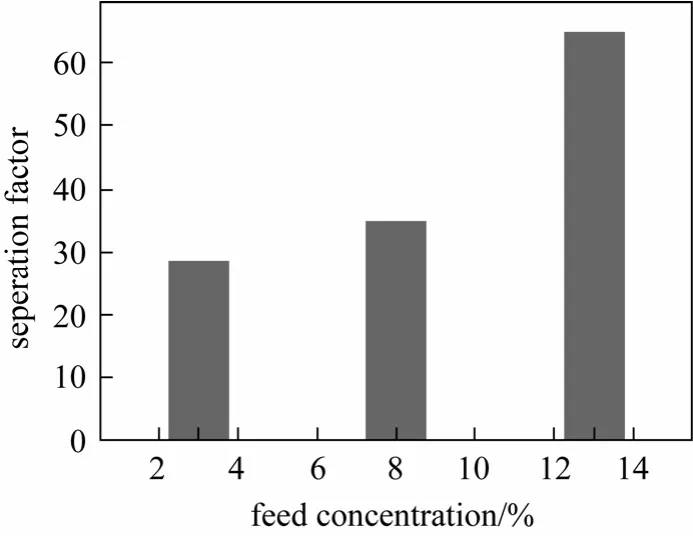
Figure 13 Effect of feed concentration on separation factor (5%ZSM-5-PDMS/Nylon, 25 °C, 50 L·h-1)
3.3.3Effect of operating temperature
The vapor pressure increases with upstream temperature, increasing the driving force of the pervaporation process. Furthermore, since PDMS is an amorphous rubbery polymer, the segments of PDMS can move more frequently at higher temperatures. The free volume of ZSM-5-PDMS/Nylon membrane is enlarged,so that the solution and diffusion of the preferentially adsorbed acetaldehyde are improved. The partial flux of acetaldehyde increases evidently with temperature but the water flux changes little (Fig. 14). Thus the separation factor increases with temperature (Fig. 15).The total permeation flux also increases with temperature, as shown in Fig. 16. For 5%ZSM-5-PDMS/Nylon membrane, the highest total flux obtained is more than 400 g·m-2·h-1at 45 °C and the separation factor can reach 50.
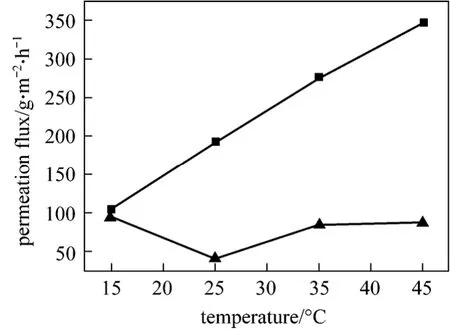
Figure 14 Effect of liquid temperature on partial permeation flux (5%ZSM-5-PDMS/Nylon, 8% acetaldehyde, 50 L·h-1)■ acetaldehyde; ▲ water
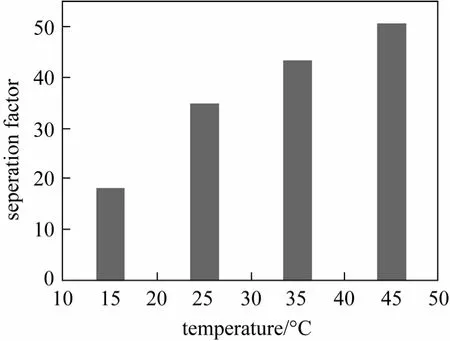
Figure 15 Effect of liquid temperature on separation factor(5%ZSM-5-PDMS/Nylon, 8% acetaldehyde, 50 L·h-1)
4 CONCLUSIONS
In this study, we prepared zeolite ZSM-5 filled PDMS composite membranes. FT-IR analysis demonstrates that the filling of ZSM-5 zeolite may destroy the crosslinking of PDMS and form hydrogen bond with oxygen in PDMS chains. The SEM analysis shows that the zeolite distributes well in PDMS when the zeolite content is proper. The DS of ZSM-5 filled PDMS/Nylon membrane is lower than that of the unfilled membrane.
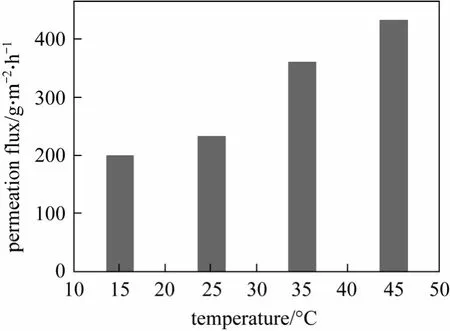
Figure 16 Effect of liquid temperature on total permeation flux (5%ZSM-5-PDMS/Nylon, 8% acetaldehyde, 50 L·h-1)
The prepared ZSM-5 filled PDMS/Nylon membranes were used to pervaporate acetaldehyde from its aqueous solution. The membrane incorporated with 5% zeolite presents the best separation characteristics.The separation selectivity is 35 with permeation flux of 233.3 g·m-2·h-1at 25 °C for 8% acetaldehyde mass concentration in the feed. Both separation factor and permeation flux increase with the feed concentration.At higher temperature, the driving force for the pervaporation process increases and the motion of polymer chains is accelerated, so that the free volume of membrane is enlarged, improving the solution and diffusion of acetaldehyde in the membrane. As a result,the separation factor and permeation flux of the composite membrane increase with temperature.
1 Zhang, X.C., Li, S.Y., Brown, R.A., Ren, J., “Ethanol and acetaldehyde in alcoholic cardiomyopathy: from bad to ugly en route to oxidative stress”,Alcohol, 32, 175-186 (2004).
2 Vaca, C.E., Fang, J.L., Schweda, E.K.H., “Studies of the reaction of acetaldehyde with deoxynucleosides”,Chem.Biol.Interact., 98,51-67 (1995).
3 Jiang, L., Lei, L.H., “Research on one-step method for synthesis of ethyl acetate separation technology”,Mod.Chem.Ind., 11, 32-33(1996). (in Chinese)
4 Chen, Z., Wu, G., Zhu, P., Hu, X., Shen, X., Li, J. X., Liu, X., “Metaldehyde production process”, CN Pat., 1150590 (1997). (in Chinese)
5 Chen, L., Zhang, N., “Pressure distillation for energy conservation in acetaldehyde production”,Mod.Chem.Ind., 3, 20-22 (1995). (in Chinese)
6 Mueller, U., Weiss, R., Diehl, K., Sandrick, G., Sauvage, L., “Separation of acetaldehyde from hydrocarbons using zeolites”, Germany Pat., 4226302 (1994).
7 Lü, X., Jing, Q., “Successive condensation of benzaldehyde and acetaldehyde for preparing cinnamaldehyde in near-critical water with ammonia as catalyst”, CN Pat., 1837171 (2008). (in Chinese)
8 Wu, Y., Huang, W.X., Xiao, Z.Y., Zhong, Y.H., “Ethanol recovery from fermentation broth by pervaporation using a composite polydimethylsiloxane”,Chin.J.Chem.Eng., 12, 586-589 (2004).
9 Peng, F.B., Jiang, Z.Y., “Modeling of pervaporation separation benzene from dilute aqueous solutions through polydimethylsiloxane membranes”,Chin.J.Chem.Eng., 13, 343-349 (2005).
10 Panek, D., Konieczny, K., “Pervaporative separation of toluene from wastewaters by use of filled and unfilled poly(dimethylosiloxane)(PDMS)membranes”, Desalination, 241, 197-200 (2009).
11 Peng, F.B., Jiang, Z.Y., Hu, C.L., Wang, Y.Q., Xu, H.Q., Liu, J.Q.,“Removing benzene from aqueous solution using CMS-filled PDMS pervaporation membranes”, Sep. Purif. Technol., 48, 229-234 (2006).
12 Papaefstathiou, I., Bilitewskib, U., de Castroa, M.D.L, “Pervaporation:An interface between fermentors and monitoring”, Anal. Chim. Acta,330, 265-272 (1996).
13 Priego-López, E., Luque de Castro, M.D., “Pervaporation-gas chromatography coupling for slurry samples determination of acetaldehyde and acetone in food”, J. Chromatogr. A, 976, 399-407 (2002).
14 Ruiz-Jiménez, J., Luque de Castro, M.D., “On-line pervaporation-capillary electrophoresis for the determination of volatile analytes in food slurries”, J. Chromatogr. A, 1128, 251-258 (2006).
15 Zeng, L., Zeng, F.J., “Study on the improvement of quality in new type Chinese Spirits by pervaporation using composite silicone rubber membrane”, Liquor Making, 31, 79-82 (2004).(in Chinese)
16 Kittur, A.A., Kariduraganavar, M.Y., Kulkarni, S.S., Aralaguppi,M.I., “Preparation of zeolite-incorporated poly(dimethyl siloxane)membranes for the pervaporation separation of isopropyl alcohol/water mixtures”, J. Appl. Polym. Sci., 96, 1377-1387 (2005).
17 Travis, C.B., Richard G.M., Leland M.V., “Stability of MFI zeolite-filled PDMS membranes during pervaporative ethanol recovery from aqueous mixtures containing acetic acid”, J. Membr. Sci., 298,117-125 (2007).
18 Liu, Y., Yu, X.B., Qin, L., Wang, J.D., Yang, Y.R., “In-situ synthesis of ZSM-5 zeolite from metakaolin/spinel and its catalytic performance on methanol conversion”, China Pet. Process. Petrochem. Technol.,12, 23-28 (2010).
19 Sun, H.L., Lu, L.Y., Chen, X., Jiang, Z.Y., “Pervaporation dehydration of aqueous ethanol solution using H-ZSM-5 filled chitosan membranes”, Sep. Purif. Technol., 58, 429-436 (2008).
20 Gu, J., Shi, X., Bai, Y.X., Zhang, H.M., Zhang, L., Huang, H., “Silicalitefilled polyether-block-amides membranes for recovering ethanol from aqueous solution by pervaporation”, Chem. Eng. Technol., 32,155-160 (2009).
21 Zhang, X.Z., Zhuo, R.X., “Synthesis of temperature-sensitive poly(N-isopropylacrylamide) hydrogel with improved surface property”, J. Colloid Interface Sci., 223, 311-313 (2000).
22 Peng, P., Shi, B.L., Lan, Y.Q., “Preparation of PDMS-silica nanocomposite membranes with silane coupling for recovering ethanol by pervaporation”, Sep. Sci. Technol., 46, 420-427 (2011).
23 Liang, L., Ruckenstein, E., “Pervaporation of ethanol-water mixtures through polydimethylsiloxane-polystyrene interpenetrating polymer network supported membranes”, J. Membr. Sci., 114, 227-234 (1996).
24 Qi, R.B., Wang, Y.J., Chen, J., Li, J.D., Zhu, S.L., “Pervaporative desulfurization of model gasoline with Ag2O-filled PDMS membranes”, Sep. Purif. Technol., 57, 170-175 (2007).
25 Luo, Y., Tan, S. J., Wang, H., Wu, F.W., Liu, X.M., Li, L., Zhang,Z.B., “PPMS composite membranes for the concentration of organics from aqueous solutions by pervaporation”, Chem. Eng. J., 137,496-502 (2008).
26 Yahaya, G.O., “Separation of phenol from aqueous streams by a composite hollow fiber based pervaporation process using polydimethyl siloxane (PDMS)/polyether-block-amide (PEBA) as two-layer membranes”, Sep. Sci. Technol., 44, 2894-2914 (2009).
 Chinese Journal of Chemical Engineering2012年4期
Chinese Journal of Chemical Engineering2012年4期
- Chinese Journal of Chemical Engineering的其它文章
- HPLC Analysis of Egg Yolk Phosphatidylcholine by Evaporative Light Scattering Detector
- Removal of Organic Matter and Ammonia Nitrogen inAzodicarbonamide Wastewater by a Combination of Power Ultrasound Radiation and Hydrogen Peroxide*
- A Geometric Approach to Support Vector Regression and Its Application to Fermentation Process Fast Modeling*
- Three Dimensional Numerical Simulation of Convection-Condensation of Vapor with High Concentration Air in Tube with Inserts*
- Nanoparticle Migration in a Fully Developed Turbulent Pipe Flow Considering the Particle Coagulation*
- Regeneration of Spent Activated Carbon by Yeast and Chemical Method*
